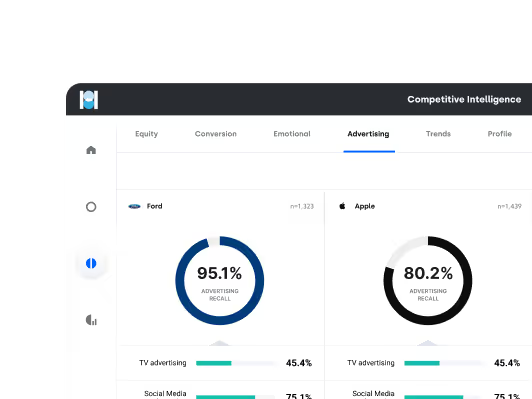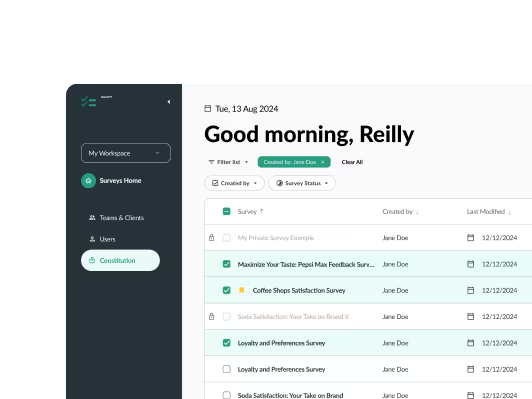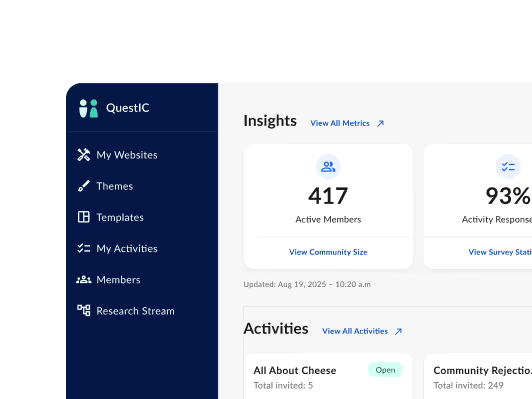1. Not defining your research objective clearly
One of the most common mistakes in survey design is failing to define the objective upfront. Without a clear goal, surveys tend to become unfocused, bloated, or full of “nice to know” questions that don’t drive actionable insights.
How to avoid it
Start every project by identifying what business decision your survey is meant to support. Frame a specific research question, then design every part of your survey to answer it.
2. Using the wrong sample or missing your target audience
You can write the perfect questions, but if you ask the wrong people, your insights won’t hold water. Sampling errors – like excluding key segments or relying too heavily on internal email lists – can lead to biased results.
How to avoid it
Define your audience with precision. Use screeners to qualify respondents, and consider tapping into vetted sample panels (like those built into QuestDIY) for accurate representation.
3. Asking biased or leading questions
Leading questions subtly nudge respondents toward a particular answer. For example, “How amazing was your experience with our product?” assumes a positive outcome. This kind of bias compromises the validity of your data.
How to avoid it
Stick to neutral, objective language. Pretest your survey with colleagues or through soft launches to identify and rework any biased phrasing.
4. Writing confusing or double-barreled questions
A double-barreled question asks about two things at once – like “How satisfied are you with our pricing and customer service?” Respondents might feel differently about each element, leading to unclear results.
How to avoid it
Keep each question focused on a single idea. Use clear, jargon-free language. Many tools (including QuestDIY) now flag problematic phrasing before you launch.
5. Providing limited or unbalanced response options
If you don’t give respondents the right range of answer choices – or if you force them to choose between irrelevant options – you risk getting skewed or meaningless data.
How to avoid it
Use balanced Likert scales and include options like “None of the above” or “Prefer not to say” when appropriate. Avoid overusing open-ended “Other (please specify)” fields, which can be hard to analyze at scale.
6. Making your survey too long
Survey fatigue is real. When a survey is too long or repetitive, people tend to drop off, rush through, or give less thoughtful answers – especially if there’s no incentive.
How to avoid it
Focus on what you need to know – not everything you could ask. Use logic branching to skip irrelevant questions and keep your survey under 10 minutes. Platforms like QuestDIY show estimated survey time and completion rates to help you stay on track.
7. Ignoring question order and flow
The order in which you ask questions can influence how people respond. For example, asking about brand awareness after you’ve shown a logo or tagline can artificially inflate recognition.
How to avoid it
Structure your survey logically – starting with easy or general questions, and gradually moving toward more specific or sensitive topics. Use randomization or rotation to minimize bias in list-style questions.
8. Failing to screen for data quality
Not every respondent will take your survey seriously. Straight-lining, speeding through, or bot-like behavior can all affect your results if not caught early.
How to avoid it
Use attention checks, set minimum completion times, and flag suspicious patterns. QuestDIY automatically screens for poor data quality, ensuring you get cleaner, more reliable responses.
9. Misinterpreting or overgeneralizing your results
It’s easy to overstate what your survey “proves.” But correlation doesn’t equal causation – and small sample sizes or non-representative audiences limit how far your insights can stretch.
How to avoid it
Frame your conclusions within the limits of your methodology. Consider follow-up research (quant or qual) to validate any high-stakes insights before acting on them.
10. Skipping a pretest or pilot
Even experienced researchers can overlook errors in logic, wording, or flow. That’s why skipping a soft launch is one of the most avoidable – but still common – survey mistakes.
How to avoid it
Always test your survey on a small audience before full deployment. Look for drop-offs, confusing questions, or odd response patterns. A tool like QuestDIY makes it easy to run pilot surveys and iterate quickly.
The bottom line: Better surveys mean better decisions
Avoiding these common survey mistakes doesn’t just improve data quality – it helps you move faster, get clearer answers, and make confident marketing or product decisions. And if you’re using an intuitive DIY survey platform like QuestDIY, many of these guardrails are built in by design:
- AI-powered question generation to avoid bias
- Research-validated structure to improve flow and logic
- Automated sample and quality checks for cleaner data
- Real-time results and dashboards for faster analysis
Whether you’re running quick-turn concept tests or measuring brand momentum, the right tool – and a little survey discipline – can make all the difference.








.jpg)

